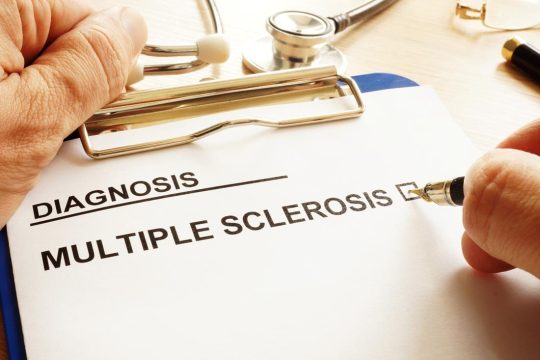Advertisment
BSH 2017: Are we ready to use minimum residual disease to direct therapy?
Studies show that MM patients who achieve minimal residual disease on treatment have longer PFS and OS than those who do not…
Professor Gordon Cook and Dr Roger Owen (Leeds General Infirmary) discuss Professor Landgren’s talk on whether we are ready to use MRD to direct therapy.
Studies show that MM patients who achieve minimal residual disease (MRD) on treatment have longer PFS and OS than those who do not. In a session on MRD-directed therapy Professor Ola Landgren from Memorial Sloan Kettering Cancer Center (MSKCC) in New York proposed that achieving MRD may indeed be more important that the actual treatment modality used, and should be included as an intermediate assessment in individually-tailored MM therapy.
The massive heterogeneity of MM and the number of sub-clones present at diagnosis1 means that highly-targeted therapy will not be appropriate first-line. Modern combination therapy has been shown to reduce the tumour burden in MM with limited toxicity, which suggests that MRD may offer a way forward of delivering precision medicine in MM. Clinical studies evaluating the efficacy of new combination therapies for MM typically have PFS as the primary endpoint, but a closer look at the results of, for example, the IFM/DFCI 2009 study shows that the improvement in PFS is accompanied by – and in Professor Landgren’s opinion caused by – a deeper response.2 In fact, although this was not an endpoint in the study, an analysis by MRD status shows that patients in both treatment arms who achieved MRD negativity had very similar PFS rates. A similar observation was made in the updated PFS results from the POLLUX study in which patients who achieved MRD negativity with a sensitivity threshold of 10-5 in both treatment arms had similar PFS rates.3
Combination therapy with carfilzomib, lenalidomide and dexamethasone (KRd) was included in the National Comprehensive Cancer Network (NCCN) guidelines based on phase II study data published in 20124 and has since been implemented at the MSKCC and more recently the Mayo Clinic. In Phase II studies KRd has shown a PFS rate of 92% and OS rates of 95%4 and 100%,5 respectively, at 18 months with median PFS and OS not reached. Rates of congestive heart failure were very low in the phase II studies and no cases of grade 3 or more peripheral neuropathy were reported.4, 5 In a study at Professor Landgren’s own centre 20 patients (44%) achieved MRD negativity after eight cycles of KRd induction; in 18 patients (46%) this status was sustained after two years of lenalidomide maintenance therapy.6 There have been no cases of congestive heart failure to date in Professor Landgren’s series, and all cases of peripheral neuropathy have been completely reversible.
The treatment paradigm for newly-diagnosed MM in the MSKCC is to use KRd as first-line therapy and then evaluate MRD status. Patients who achieve MRD negativity with a sensitivity threshold of 10-6 are offered the option of ASCT followed by maintenance, or maintenance therapy alone. Patients who do not achieve MRD negativity are recommended to have an ASCT and then proceed to maintenance therapy. No difference is made between standard-risk and high-risk patients. At present a number of patients remain MRD-negative on extended maintenance therapy which has prompted Professor Landgren to consider the clinical value of sustained MRD negativity and whether these patients should remain on maintenance therapy – in the absence of study data the intuitive answer is probably yes.
Clinical studies are ongoing at the MSKCC to determine the place of high-dose KRd and KRd with daratumumab in the treatment paradigm. Intense work also goes into developing and improving techniques for clonal characterisation and disease monitoring post-treatment, such as the myTYPE targeted exome sequencing assay which is myeloma-specific and capable of identifying treatment targets for small molecule and immune therapy, as well as candidate genes for conveying increased myeloma risk. However, Professor Landgren stressed that although it probably is the case that achieving MRD negativity is more important than the actual treatment modality, for patients there is much more to life than assays and reducing the disease burden with minimum toxicity should be at the top of the clinician’s mind.
References
- Lohr JG, Stojanov P, Carter SL, et al. Widespread genetic heterogeneity in multiple myeloma: implications for targeted therapy. Cancer Cell 2014;25:91-101.
- Attal M, Lauwers-Cances V, Hulin C, et al. Autologous Transplantation for Multiple Myeloma in the Era of New Drugs: A Phase III Study of the Intergroupe Francophone Du Myelome (IFM/DFCI 2009 Trial). Blood 2015;126:391-391.
- Avet-Loiseau H, Casneuf T, Chiu C, et al. Evaluation of Minimal Residual Disease (MRD) in Relapsed/Refractory Multiple Myeloma (RRMM) Patients Treated with Daratumumab in Combination with Lenalidomide Plus Dexamethasone or Bortezomib Plus Dexamethasone. Blood 2016;128:246-246.
- Jakubowiak AJ, Dytfeld D, Griffith KA, et al. A phase 1/2 study of carfilzomib in combination with lenalidomide and low-dose dexamethasone as a frontline treatment for multiple myeloma. Blood 2012;120:1801-9.
- Korde N, Roschewski M, Zingone A, et al. Treatment With Carfilzomib-Lenalidomide-Dexamethasone With Lenalidomide Extension in Patients With Smoldering or Newly Diagnosed Multiple Myeloma. JAMA Oncol 2015;1:746-54.
- Kazandjian D, Korde NS, Roschewski M, et al. Sustained Minimal Residual Disease Negativity in Newly Diagnosed Multiple Myeloma (NDMM) Patients Treated with Carfilzomib (CFZ), Lenalidomide (LEN), and Dexamethasone (DEX) Followed By 2 Years of Lenalidomide Maintenance (CRd-R): Updated Results of a Phase 2 Study. Blood 2016;128:4527-4527.





